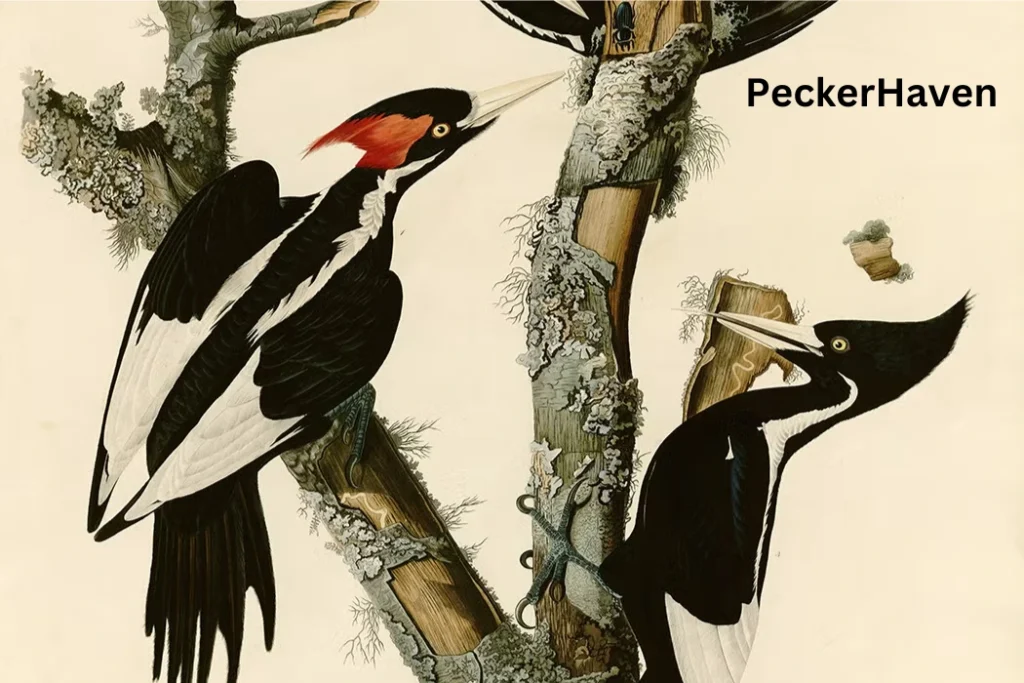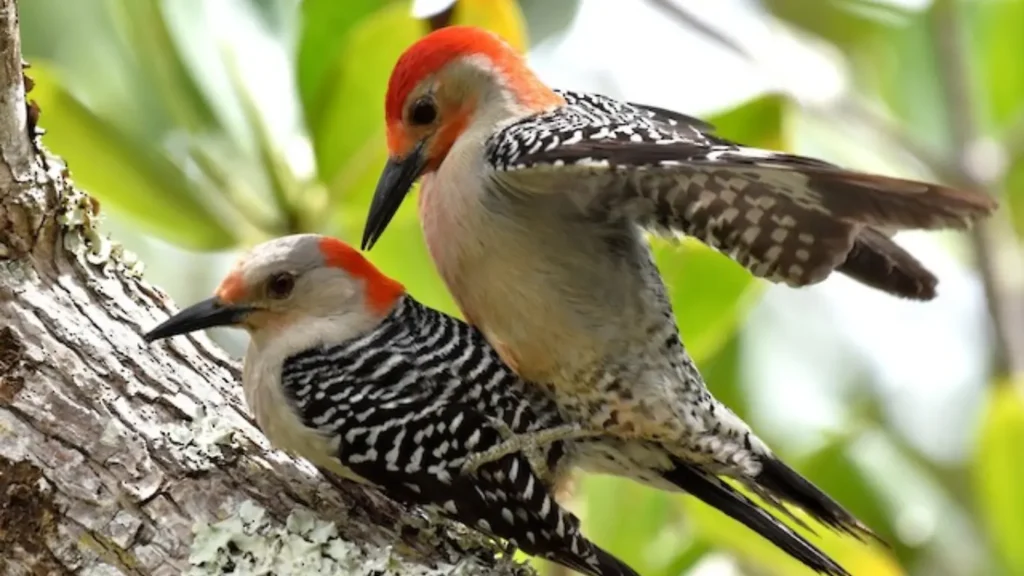
The ivory-billed woodpecker, the former majestic bird of America’s southeast, has itself been made a symbol of nature’s loveliness and the deadly power of man’s ingenuity. Nicknamed the “Lord God Bird” due to its massive size and deep, resounding call, the bird has long fascinated mankind. But, regrettably, it is also a mystery bird, with an uncertain destiny. The largest question that has hung over this legendary bird is: when did the ivory-billed woodpecker vanish? This article examines the timeline of its disappearance, the final reported sightings, and the current search to ascertain if indeed this incredible bird still exists, and also broaches the current controversy of are woodpeckers extinct in general, and the particular case of the ivory-billed woodpecker.
The Ivory-Billed Woodpecker: A Majestic Bird
Let us discuss the ivory-billed woodpecker first before we tell you what became of it. Try to visualize in your mind a bird bigger than a crow, with wide black and white bands. The male has a red crest, and they both have a humongous ivory-tipped bill – that is how it gets its name. That huge size of the ivory-billed woodpecker was so beautiful to behold. They were bark-eating birds with strong bills employed to peel bark from dead trees in the expectation of revealing insects. They inhabited large, old-growth forests, especially cypress swamps and bottomland hardwood forests of the southeastern United States.
Habitat and Diet of the Ivory-Billed Woodpecker
The ivory-billed woodpecker occurred in extensive blocks of old forest, and it was therefore highly sensitive to forest destruction. It had a diet mainly made up of larvae of beetle-boring beetles, which it harvested from dead and dying trees. It was a specialist diet that needed a constant source of these massive dead trees, which were removed when forests were cut down. It’s a significant issue in figuring out how many ivory-billed woodpeckers are alive because their particular habitat has been sharply diminished.
The “Lord God Bird”: A Name with History
The ivory-billed woodpecker was referred to as the “Lord God Bird” and is purported to have been named such from the “wow” that the lucky ones would let out upon sighting this beauty on the wing. Its deep call, a loud and ringing “kent,” added to its mystique. You can still listen to recordings of the ivory-billed woodpecker call on the web, an evocative reminder of the bird itself.
The Decline of the Ivory-Billed Woodpecker: A Timeline

The. ivory-billed woodpecker’s past record of decline is a sorry one of loss of habitat and human action. As the old-growth forests were brought down for agriculture, timber production, and settlement, the bird’s habitat was significantly curtailed. Coupled with the pressure of hunting, this reduction in habitat resulted in their populations declining steadily. This loss is drawn most in comparison to that of the ivory-billed woodpecker in relation to the pileated woodpecker, for the pileated woodpecker, having a similar appearance but different habitat inclinations, has survived and thrived.
Early 20th Century: A Shrinking Population
By the start of the 20th century, ivory-billed woodpeckers were already an extinct species. Logging was more concentrated, with more fragmenting and destruction of the remaining forests. Fewer sightings of ivory-billed woodpeckers were seen, and fear of extinction started to set in.
Mid-20th Century: Last Confirmed Sightings
Hankering, in the mid-20th century, the ivory-billed woodpecker was slain. There were reports endlessly but too frequent to nail it down. Its last confirmed sighting was that in 1944 in Louisiana. Though their stay was agonizingly short-lived, proof this bird existed, if troubled, there at least was solid.
| Year | Event | Location |
|---|---|---|
| 1944 | Last universally accepted confirmed sighting | Louisiana |
| 2004 | Video footage sparks renewed hope | Arkansas |
The 2004 Arkansas Sighting: Hope and Controversy
Cornell scientists videotaped some footage in 2004 that they said contained an ivory-billed woodpecker. That report sparked the second wave of excitement and collective searching. That brief, low-resolution clip didn’t do much to convince scientists that they really did see what they had claimed, however. These false ivory-billed woodpecker sightings, even though baseless, do make one wonder if maybe this bird does exist.
When Did the Ivory-Billed Woodpecker Become Extinct? The Uncertain Answer
In spite of the 2004 appearance, definitive evidence of the existence of the ivory-billed woodpecker continues to be nonexistent. As complex a question as when did the ivory-billed woodpecker go extinct is, the fact that the last confirmed sighting was in 1944 is somewhat negated by the hope provided by the 2004 video, at least temporarily.
Official Status: Extinct, but Hope Lingers
The ivory-billed woodpecker is formally ranked as “extinct” or “possibly extinct” on certain lists of conservation. But since there has been no absolute evidence of extinction, along with the 2004 observation, there remains hope for the fact that a small population may still exist in some remote corner of its former range.
Ongoing Search Efforts: The Quest Continues
In spite of the difficulties, the ivory-billed woodpecker continues to be searched for. Researchers and birdwatchers still survey for regions where the bird can possibly be found in order to confirm whether or not the bird continues to exist. Such efforts typically consist of releasing acoustic monitoring equipment, camera traps, and foot patrols in deep woods.
The Importance of the Ivory-Billed Woodpecker
The ivory-billed woodpecker is today an icon of conservation worth. Its tale brings home to us the horrific effects of losing habitats and the importance of saving our world’s diversity.
A Symbol of Conservation
The ivory-billed woodpecker’s plight serves as a stark reminder of the fragility of ecosystems and the impact of human actions. Its disappearance underscores the need for proactive conservation measures to protect endangered species and their habitats.
Lessons Learned: Protecting Endangered Species
The ivory-billed woodpecker’s history is a lesson for conservationists. It shows the importance of habitat conservation, the importance of long-term monitoring programs, and the importance of community involvement in conservation.
Summary: A Ghost of the Forest
When did the ivory-billed woodpecker go extinct is a question one cannot answer with absolute certainty. Although the last confirmed sighting of the ivory-billed woodpecker was 1944, the 2004 video tape provides us with glimmer of hope. Whether the ivory-billed woodpecker exists or not or maybe is actually gone, its tale is one which reminds us most forcefully the value of conservation as well as our world’s irreplaceable biodiversity. The search goes on, powered by hope and a resolve to make sure this incredible bird doesn’t disappear totally into the books of history. The argument regarding the number of ivory-billed woodpeckers is serving to highlight the mystery of this elusive bird.
FAQs
Some of the most common ivory-billed woodpecker questions are:
When was the ivory-billed woodpecker last spotted?
The ivory-billed woodpecker has the best-documented documented sighting, and that was in Louisiana in 1944.
Did the ivory-billed woodpecker appear in 2004?
2004 Arkansas video surprised people, although scientists do not believe in such video.
Is the ivory-billed woodpecker extinct?
Its status is “possibly extinct” or “extinct,” survival not ruled out, that’s the kind of speculation one can’t resist when attempting to evaluate whether woodpeckers as a group are extinct, the proving ground of a thin survival for so many birds.
How and why the ivory-billed woodpecker became extinct?
The destruction of the habitat by logging, agriculture, and urbanization mostly contributed to this. Worst of all was the loss of habitat of the ivory-billed woodpecker.
What are they doing to locate the ivory-billed woodpecker?
The bird researchers and the bird enthusiasts are searching for it and employing every observation technique in potential habitats. They are encouraged by gaining ultimate proof that the bird still exists.
